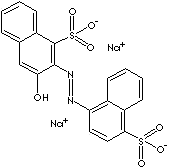PRODUCT IDENTIFICATION

H.S.CODE
TOXICITY
SMILES
c12c(c(\N=N/c3c(c4c(cccc4)c(c3)S(=O)(=O)[O-])O)ccc1S(=O)(=O) [O-])cccc2.[Na+].[Na+]
CLASSIFICATION
Food coloring, Azo dye
EXTRA NOTES
Overall Carcinogenic Evaluation: Group 3
PHYSICAL AND CHEMICAL PROPERTIES
red powder
Soluble (120g/l)
REFRACTIVE INDEX
EXTERNAL LINKS & GENERAL DESCRIPTION
Wikipedia Linking - Azorubine
Google Scholar Search - Carmoisine
Drug Information Portal (U.S. National Library of Medicine) - Carmoisine
PubChem Compound Summary - Carmoisine
KEGG (Kyoto Encyclopedia of Genes and Genomes) - Carmoisine
http://www.ebi.ac.uk/ - Carmoisine
http://www.ncbi.nlm.nih.gov/ - Carmoisine
http://toxnet.nlm.nih.gov/
Hazardous
Substances Data Bank - Carmoisine
Local:
CARMOISINE is a synthetic acid dye containing both NN and CC chromophore groups (pyrazolone dye). It is a red dye; soluble in water; melting point >300 C; used in coloring food, cosmetics and meications (C.I. Food Red 3). But it is banned by the FDA due to carcinogen suspect. The chemical designation is 4-hydroxy-3-(4-sulfonato-1- naphthylazo) naphthalene-1-sulfonate, disodium salt. Acid dyes are water-soluble dyes employed mostly in the form of sodium salts of the sulfonic or carboxylic acids. They are anionic which attach strongly to cationic groups in the fibre directly. They can be applicable to all kind of natural fibres like wool, cotton and silk as well as to synthetics like polyesters, acrylic and rayon. But they are not substantive to cellulosic fibres. They are also used in paints, inks, plastics and leather.
APPEARANCE
DYE CONTENT
85.0% min
10.0% max
WATER INSOLUBLES
0.2% max
1.5% max
0.5% max
3ppm max
10ppm max
1ppm max
HAZARD OVERVIEW
Causes skin irritation. Causes serious eye irritation. May cause respiratory irritation
GHS
Warning
PICTOGRAMS

HAZARD STATEMENTS
H315-H319-H335
P STATEMENTS
P261-P305 + P351 + P338
![]()
RISK PHRASES
36/37/38
SAFETY PHRASES
26-37/39
PRICE INFORMATION